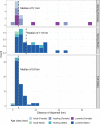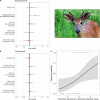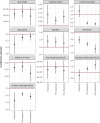Agricultural land use shapes dispersal in white-tailed deer (Odocoileus virginianus)
- PMID: 36289549
- PMCID: PMC9608933
- DOI: 10.1186/s40462-022-00342-5
Agricultural land use shapes dispersal in white-tailed deer (Odocoileus virginianus)
Abstract
Background: Dispersal is a fundamental process to animal population dynamics and gene flow. In white-tailed deer (WTD; Odocoileus virginianus), dispersal also presents an increasingly relevant risk for the spread of infectious diseases. Across their wide range, WTD dispersal is believed to be driven by a suite of landscape and host behavioral factors, but these can vary by region, season, and sex. Our objectives were to (1) identify dispersal events in Wisconsin WTD and determine drivers of dispersal rates and distances, and (2) determine how landscape features (e.g., rivers, roads) structure deer dispersal paths.
Methods: We developed an algorithmic approach to detect dispersal events from GPS collar data for 590 juvenile, yearling, and adult WTD. We used statistical models to identify host and landscape drivers of dispersal rates and distances, including the role of agricultural land use, the traversability of the landscape, and potential interactions between deer. We then performed a step selection analysis to determine how landscape features such as agricultural land use, elevation, rivers, and roads affected deer dispersal paths.
Results: Dispersal predominantly occurred in juvenile males, of which 64.2% dispersed, with dispersal events uncommon in other sex and age classes. Juvenile male dispersal probability was positively associated with the proportion of the natal range that was classified as agricultural land use, but only during the spring. Dispersal distances were typically short (median 5.77 km, range: 1.3-68.3 km), especially in the fall. Further, dispersal distances were positively associated with agricultural land use in potential dispersal paths but negatively associated with the number of proximate deer in the natal range. Lastly, we found that, during dispersal, juvenile males typically avoided agricultural land use but selected for areas near rivers and streams.
Conclusion: Land use-particularly agricultural-was a key driver of dispersal rates, distances, and paths in Wisconsin WTD. In addition, our results support the importance of deer social environments in shaping dispersal behavior. Our findings reinforce knowledge of dispersal ecology in WTD and how landscape factors-including major rivers, roads, and land-use patterns-structure host gene flow and potential pathogen transmission.
Keywords: Agricultural land use; Cervid; Chronic wasting disease; Gene flow; Movement barriers; Pathogen spread; Resource selection; Social ecology; Step selection analysis; Wisconsin.
© 2022. The Author(s).
Conflict of interest statement
The authors declare that they have no competing interests.
Figures







References
-
- Gaines MS, McClenaghan LR., Jr Dispersal in small mammals. Annu Rev Ecol Syst. 1980;11:163–96.
-
- Slarkin M. Gene flow in natural populations. Annu Rev Ecol Syst. 1985;16:393–430.
-
- Murray BG., Jr Dispersal in Vertebrates Ecology. 1967;48:975–8.
-
- Lang KR, Blanchong JA. Population genetic structure of white-tailed deer: Understanding risk of chronic wasting disease spread. J Wildl Manage. 2012;76:832–40.
LinkOut - more resources
Full Text Sources

